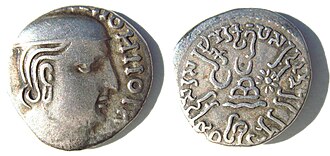Top Qs
Timeline
Chat
Perspective
Rudrasimha I
Western Kshatrapa ruler from 178 to 197 From Wikipedia, the free encyclopedia
Remove ads
Rudrasimha I was a Western Kshatrapa ruler, who reigned from 178 to 197 CE. He was son of Rudradaman I, grandson of Jayadaman, and grand-grandson of Chashtana.[3] During his reign, the Abhiras became increasingly important. Some of them were even serving as generals.[4] Ashvini Agrawal thinks that the Abhira king Isvardatta was a general in the service of Rudrasimha I who deposed his master in 188 A.D and ascended the throne. Ashvini Agrawal further says that Rudrasimha I soon deposed him and regained the throne in 190 A.D.[4]


Remove ads
Reign
Summarize
Perspective
Numismatics and Epigraphics
From the reigns of Jivadaman and Rudrasimha I, the date of minting of each coin, reckoned in the Saka era, is usually written on the obverse behind the king's head in Brahmi numerals, allowing for a quite precise datation of the rule of each king.[5][6] This is a rather uncommon case in Indian numismatics. Some, such as the numismat R.C Senior considered that these dates might correspond to the much earlier Azes era instead.
Influence of Abhiras
During his reign, the Abhiras became increasingly important. Some of them were even serving as generals.[4] Ashvini Agrawal thinks that the Abhira king Isvardatta was a general in the service of Rudrasimha I who deposed his master in 188 A.D and ascended the throne. Ashvini Agrawal further says that Rudrasimha I soon deposed him and regained the throne in 190 A.D.[4]
Rudrasimha I is also known for an inscription in Sanskrit at Gunda, north Kathiawar, mentioning "the digging of a well for the welfare of society by Senapati Bapaka's son, Rudrabhuti Abhira", and dated to Saka era 103 (181 CE).[7][8][9][3] The inscription also gives a detailed genealogy of the kings up to Rudrasimha:[10]
"Hail ! On the [auspicious] fifth tithi of the bright fortnight of Vaisakha during the auspicious period of the constellation of Rohini, in the year one hundred and three — 100 3 — (during the reign) of the king, the Kshatrapa Lord Rudrasiha (Rudrasimha), the son of the king, the Maha-Kshatrapa Lord Rudradaman (and) son’s son of the king, the Kshatrapa Lord Jayadaman, (and) grandson’s son of the king, the Maha-Kshatrapa Lord Chashtana, the well was caused to be dug and embanked by the general (senapati) Rudrabuthi, the son of the general (senapati) Bapaka, the Abhira, at the village (grama) of Rasopadra, for the welfare and comfort of all living beings."
— Epigraphia Indica XVI, p.233
The inscription refers Rudrasimha to as simply a ksatrapa, ignoring the existence of any mahaksatrapa. According to Sudhakar Chattopadhyaya, this indicates that the Abhira general was the de facto ruler of the state, though not assuming any higher title. The inscription states Abhira Rudrabhuti as the son of the general Bapaka.[11] The Abhira dynasty was probably related Abhira Rudrabhuti.[12][11]
Remove ads
Notes
References
Wikiwand - on
Seamless Wikipedia browsing. On steroids.
Remove ads


